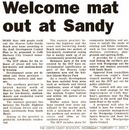Cantina Casuarina
 Americans know it as the Australian pine, and it's a pest over there, but we call our native tree the Casuarina (its species name), or She-oak, and it's a necessary part of our ecology. In the US, it's our payback for Hollywood.
Americans know it as the Australian pine, and it's a pest over there, but we call our native tree the Casuarina (its species name), or She-oak, and it's a necessary part of our ecology. In the US, it's our payback for Hollywood. I call them Casuarinas, mostly. A nice word, like ocarina, cantina, Angelina and senorita. Sweet, like a Bob Dylan love song. In my memory and imagination, I always associate them with many picnics in many places, boiling the billy in their shade, by beach, river, lake, lagoon or creek.
By the way, they are neither oak nor pine, though they remarkably resemble a pine, with their needle leaves and cone-style fruit. Like 600 other species in this country, it's a Eucalypt. No other continent is so dominated by one genus of tree as Australia is by eucalypts. We Aussies have eucalyptus oil in our veins, and often when overseas, will send home for some leaves to burn, just to get the aroma.
The Casuarinas, and the heath they inhabit, form a boundary between the frontal dune area of Sandy Beach -- which is very low for most of the length of Sandy, with bigger dues up the south end -- and the now-cleared land spreading back from the shore. The land I live on. That land itself was probably Casuarina heath, too, before the advent of Europeans, not so very long ago.
Today, after some showers of rain overnight and in the morning, a small flock of Scaly-breasted lorikeets (pictured) were munching on one of the fruits that they love, as do the Crested pigeons, galahs and any number of pretty birds. That fruit is the fruit of the Casuarina, which today are plentiful. They're marble-sized and look like suede-covered landmines, or furry chocolate-peanut nuggets, but they taste like crap. Trust me. Not to the birds, though. They're crazy about 'em. Beats me.
Australia's national poet, Henry Lawson, often mentioned Casuarinas, or She-oaks, in verse and tale. In this stanza he is referring to his home town of Grenfell in this state, where he was born in a tent on the goldfields:
Said Grenfell to my spirit,
"You've been writing very free
Of the charms of other places,
and you don't remember me.
You have claimed another native place
and think it's Nature's law,
Since you never paid a visit
to a town you never saw:
So you sing of Mudgee Mountains,
willowed stream and grassy flat:
But I put a charm upon you
and you won't get over that.
"O said Grenfell to my spirit,
"Though you write of breezy peaks,
Golden Gullies, wattle sidings,
and the pools in she-oak creeks,
Of the place your kin were born in
and the childhood that you knew,
And your father's distant Norway
(though it has some claim on you),
Though you sing of dear old Mudgee
and the home on Pipeclay Flat,
You were born on Grenfell goldfield –
and you can't get over that."
(Quite a heritage Lawson had. His mother, Louisa Lawson, is the woman who Australian women can most thank for their right to vote.)
 While the scalies were up in the casuarinas, doing acrobatics in that cute parrot way, chewing on their fuzzy, chaffy nuggets, a flock of Crested pigeons was beneath them, grazing on fallen fruits, and probably grass seeds. They prefer their meals on the ground, but were quick to fly up among their green-and-red Scaly-breasted lorikeet cousins when the strange Almanac bloke approached.
While the scalies were up in the casuarinas, doing acrobatics in that cute parrot way, chewing on their fuzzy, chaffy nuggets, a flock of Crested pigeons was beneath them, grazing on fallen fruits, and probably grass seeds. They prefer their meals on the ground, but were quick to fly up among their green-and-red Scaly-breasted lorikeet cousins when the strange Almanac bloke approached.Six months or so ago a huge storm blew across Sandy. It was the fiercest windy night I've experienced in my more than half century. Come morning, there were a lot fewer trees for the birds to eat from, lots of them laid flat and pointing to the sunset, as I guess the wind came from the ocean, although it was too wild in the gumtrees and mango tree around my cabin for me to know where the hell it came from. Hell, probably.
Casuarinas are not strong-wooded trees as they stand, despite having a good working timber, so it's not surprising to see that Lawson wrote on another occasion:
That night the rain in torrents dashed,
The sky seemed flushed with blood,
And here and there the she-oaks crashed
Beneath the yellow flood.
Up the north end of the beach and facing west, for about a year, there has been a big sign erected by Council announcing that some of the trees that were there had been poisoned. It's a warning that Council is aware that there are some weird people who prefer dinner parties with an ocean view to a stand of native trees. I'm not real big on signs, but that one's a bottler. I think the scalies appreciate it too ... and the native pigeons, the Bearded dragons, the possums, the tree snakes, the Black-tailed cockatoos, the Blue wrens, the Red-backed wrens, the peewees, the Willy wagtails ...




















 The following letter came from Stuart Buchanan of
The following letter came from Stuart Buchanan of  The meeting last night was very well attended, with I guess about 70 people concerned about development plans for Sandy Beach and Hearns Lake. The meeting was called by a new group, Sandy/Hearns Action group (SHAG).
The meeting last night was very well attended, with I guess about 70 people concerned about development plans for Sandy Beach and Hearns Lake. The meeting was called by a new group, Sandy/Hearns Action group (SHAG). Among other creatures, the lake vicinity is home to an endangered species, the
Among other creatures, the lake vicinity is home to an endangered species, the 



 If you enjoy flaneuring with A Sandy Beach Almanac, I think you'll enjoy it more with a daily flaneur down
If you enjoy flaneuring with A Sandy Beach Almanac, I think you'll enjoy it more with a daily flaneur down 

 Readers living in this neck of the South Pacific might be interested to know that there are now two radio stations on which your almanackist is appearing regularly.
Readers living in this neck of the South Pacific might be interested to know that there are now two radio stations on which your almanackist is appearing regularly.






 He certainly would have found, like people of many nations, that he had something with which to weave baskets, and it sounds like he could have used the diversion as there was no TV on his island way out there off the coast of Chile, not even with a dish. And if he had thought about it, the fibrous, almost hollow trunks of Pandanus float so well (they're often found washed up around here), he could have made a raft from them.
He certainly would have found, like people of many nations, that he had something with which to weave baskets, and it sounds like he could have used the diversion as there was no TV on his island way out there off the coast of Chile, not even with a dish. And if he had thought about it, the fibrous, almost hollow trunks of Pandanus float so well (they're often found washed up around here), he could have made a raft from them.


